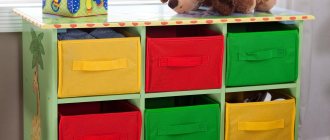Probably only a very pedantic person, for whom everything in life has its own place, can boast of perfect order in the closet. For most people, the issue of storing things is not so significant; many do not ask themselves how to properly put things in the closet, they store them haphazardly.
It seems simple enough, but sometimes, due to improper storage, there is not enough space even in a large closet.
Meanwhile, things are a powerful carrier of energetic information about their owner, and by keeping them in an orderly manner, you can significantly change your life, get rid of the turmoil and adversity in it. Therefore, it is imperative to organize the storage of things in the closet and maintain order in it at all times.
To ensure that all things are in perfect order, and the space is not overloaded, it is worth knowing a few simple but effective secrets.
Wardrobe for pumping: 15+ tips for storing clothes and shoes
You open your closet and you have absolutely nothing to wear. At the same time, the wardrobe is simply bursting with things. If this situation is familiar to you, our material may be useful.
Visual characteristics
Storage boxes and cases can be used not only as an organizer, but also as an independent decorative element. Elegant modules selected in the same style will harmoniously fit into the interior of the hallway, dressing room, bedroom, and nursery. Boxes with bright prints will cheer you up on a stormy day, while plain classic ones, made from high-quality laminated cardboard, will create a feeling of order and peace.
Wicker baskets and boxes in pastel shades will organically complement interiors made in provincial (Provence, country) and ethnic (Moroccan, Mediterranean) styles.
You can choose organizers that are plain, with an unobtrusive discreet print, a bright floral pattern, or painted ones - for children's things.
As you can see, ordinary cases and boxes can significantly modify the storage system and transform the interior. We hope that our recommendations will serve as a starting point in finding your own style of arranging your living space.
Where do unnecessary things come from?
Man is a very thrifty creature by nature, everyone is taught this from childhood, so in adult life everyone is very sorry to part with their favorite and not so favorite things. Having stored them for years on the shelves of a wardrobe, a person constantly convinces himself that maybe someday he will wear an old dress or lose weight to “fit into” his favorite jeans.
First of all, you need to conduct a global audit and go through absolutely all things.
But often, this is also confirmed by psychologists: “An item that has been gathering dust on a shelf for several years is unlikely to be worn in the future,” so after auditing your own wardrobe, it is worth getting rid of things that have not been worn for several years, forever.
It will take some time, but the result will pleasantly please you.
Important! Psychics vying with each other to repeat that it is absolutely forbidden to store broken, torn, worn-out things! You should part with them immediately, so as not to attract negativity, quarrels and financial difficulties.
If it’s simply a shame to throw away items from your wardrobe, you can always take them to a thrift store, and you can also earn extra money for new clothes.
It is better to immediately take dilapidated and old wardrobe items to a landfill or burn them.
Important! Each item stores energy information about the owner; loved ones, which they wear with joy, attract positive energy, unloved or “forgotten” ones take this energy away.
How to store pants
There are no big problems in how to preserve trousers - many devices have been invented for this. In addition to the traditional crossbar on hangers, modern wardrobes are often equipped with retractable crossbars. But clothes made of wool or knitwear, after hanging on such a crossbar for six months, are stretched at the bend, and if you use a hanger with clothespins, marks will remain on the soft fabric. Therefore, the best way to store trousers for a long time is a hanger that clamps the entire width of the trouser legs at the bottom.
Getting rid of unnecessary things, or organizing an audit of things in the closet
To begin with, you need to take out all the things without exception from the closet, both seasonal and not, then you need to:
- Carefully check for wear, stains, holes and other damage;
- Set aside items that are worn constantly, separately those that have been worn several times or are inappropriate in size, and, of course, those that have not been worn for a very long time (1-2 years);
- It’s much easier with children’s things; those that the child has grown up need to be distributed to families with children or sent to the attic if more children are planned.
Those things that still cannot be thrown away must be placed in a separate box, and if after a while you don’t remember about it, then you can safely get rid of them.
How to store dresses
Dresses made from soft jersey are usually stored folded, like sweaters or turtlenecks. All the rest rightfully take up space in the closet - it’s not for nothing that they call it a wardrobe. Hangers for thin dresses are covered with fabric to protect the material from snagging; for thicker fabrics, wooden or plastic hangers are suitable. Difficulties arise when you need to decide how to store evening dresses with complex necklines that are worn very rarely. Complex hangers with several fasteners and covers for clothes come in handy here. Silk dresses are treated with an antistatic agent before being placed in the closet.
How to store things in a closet: let's put everything on shelves
To put things in order, you must first take into account the following criteria.
- Seasonality of things.
Those that are not suitable for the season must be carefully placed on the mezzanine, near the back wall on a shelf, in a separate drawer of the chest of drawers.
It is necessary to use storage places for them in which they will remain securely for the next 6 months, without constantly being seen.
- Category.
- Outerwear is best stored on hangers or in special cases.
You can make them yourself, for example, from large transparent plastic bags.
- Shoes – be sure to put shoes in boxes to avoid deformation.
Fill the inside of the boxes with paper.
- Casual clothes can fit perfectly on shelves.
Only on the condition that it is made of fabrics that are not very wrinkled.
- Formal weekend or formal classic clothes should definitely hang on hangers in a closet with a rod.
Choose the same hangers, or at least let them be from the same series.
- Sanitary and hygienic items - towels, bed linen, bathrobes and other items can be stored on the shelves of the wardrobe.
They can also be placed in a chest of drawers or on mezzanines.
Having decided on the categories of things, you need to allocate them their own, permanent place. Place them neatly and beautifully there, and strictly maintain them in this form at all times.
How to store hats and caps
It’s easy for lovers of woolen hats: put your winter friend in a bag and forget about it until the next cold weather. But where and how to store fur hats in the summer is a more serious question. Fur products need to be protected not only from moths, dust, moisture and bright light, but also from squeezing. Hats are put on a special blank and placed in cardboard hat boxes. Instead of a blank, you can use crumpled newspaper, but do not stuff it too tightly. Even if the lid of the container does not sag, resist the temptation to stack a tower of boxes: there can be at most one more packed hat on top.
Proper use of space, or how to properly arrange things in a closet?
It is believed that choosing items for storing things should take into account the clothing preferences of each family member.
- A wardrobe with shelves - if the family prefers a sporty style of clothing, jeans, raglans and T-shirts.
This type of storage is suitable for things that do not wrinkle and are easy to iron.
- A wardrobe with a barbell is for families whose members hold positions requiring them to give preference to strict classics in clothing.
This will make it convenient to store skirts, dresses, and suits.
- A wardrobe with a rod and shelves is a universal option that takes into account the wardrobe preferences of each family member.
But often there aren’t enough shelves for all the things.
- A chest of drawers is a great place to store towels, bedding, underwear, tights, stockings, socks and other small items.
As a rule, it is convenient to store all small items (underwear, socks) in drawers; access to them in this case is very comfortable.
Ties and belts can be hung on special hangers present in every closet.
Such sections are often narrow and no higher than 20 centimeters.
Clothes are usually folded on shelves in piles, separately by category, separating dark, light and colored.
Clothes should be sent to the closet clean and ironed.
How to store T-shirts
Light knitted T-shirts and turtlenecks are often hung on hangers. And if the material is not too heavy, then nothing bad happens. If the crossbar in the closet is already cramped, then it would be equally correct to store folded T-shirts in a container or simply on shelves. Many people have difficulty folding them; in this case, there are even special boards for folding T-shirts, which, however, are also suitable for folding shirts and thin sweaters for travel. To save even more space, T-shirts can be rolled into a roll after folding. It is only important to ensure that the folds do not fall on the dense print that adorns the clothing.
See how you can quickly fold a T-shirt:
Storing things on hangers, some practical tips
To ensure that things on hangers do not lose their attractiveness, do not become covered with dust and do not wrinkle, you need to follow simple rules.
- Put on covers.
Things in cases will retain their appearance and quality longer.
- Do not clutter the bar too much, distribute things so that there is space between each item of clothing.
The most popular items should be at eye level.
- Never put several things on one hanger.
After hanging the outfit on a hanger, fasten all the buttons, fasteners and zippers on it.
- For jackets and dresses, use hangers with wide hangers.
For trousers, there are options with clothespins or hangers built into the closet.
- Turning the hook to face yourself is more beautiful.
It is necessary to allocate compartments in the closet for clothes that are currently being worn.
- Select hangers depending on the size of your clothing to avoid stretching.
The hangers on which you hang clothes must be correctly matched to the size of the outfit.
By following these small tips, you can easily organize the storage of things in your closet with your own hands very quickly, beautifully and harmoniously. The main thing to remember is that when we get rid of the unnecessary and old, we attract the new and necessary.
Organizing your closet will definitely contribute to harmony and order in your life!
How to store sweaters
When putting away warm clothes for the summer, many people think about how best to store sweaters, cardigans and other woolen, cashmere or knitted items: folded or on hangers? It is advisable to use a trunk or clothing container. Over several months of hanging motionless, the material of the sweater will stretch under its own weight or be squeezed out by the corners of the hanger on the shoulders. The only exceptions may be cardigans or jackets, which can be hung on soft foam hangers. Do not overcrowd the container - the air gap between the layers of fabric will protect against the unpleasant smell of caked fabric. For the same purpose, trunks for wool are made of linen and cardboard - plastic impedes the flow of air, and the holes made in it will also serve as a passage for moths.
We send out-of-season items for storage
All out-of-season clothing, after being put in order, is sent for storage. It is best to use fabric containers rather than plastic ones.
It is better to store outerwear in fabric covers.
Everything that is not needed now can be put into storage.
Seasonal clothing
Before sending items for storage, they need to be washed and dried thoroughly, dry-cleaned or aired if it is a sheepskin coat or fur coat.
Don't forget to make minor repairs - sew on missing buttons, mend holes. Check your pockets: even small items left behind can damage the fabric.
Wardrobes and chests of drawers with seasonal items should be ventilated at least once a month. If you live in a humid climate, install moisture traps in your cabinets. They look like bags or boxes filled with beads, similar to the ones you find in shoe boxes in stores. The gel in the balls absorbs water vapor from the air.
Hang between the hangers and place aromatic sachets on the shelves; the scents of lavender, sandalwood, jasmine, geranium and cloves are suitable.
These are general recommendations. Now let's go through the rules for summer and winter items separately.
Storing summer clothes in winter
First, decide which things you definitely won’t wear in the cold. For example, thin T-shirts can be worn under jumpers, and basic summer dresses can be worn with warm cardigans.
Most often, short-sleeved shirts, thin blouses, cocktail dresses, light jackets, shorts, skirts and sundresses go into closets for the winter.
It is convenient to store cotton items in vacuum bags. However, if you have free shelves or drawers, clothes can be folded in piles or rolled into rolls.
If there is at least 30-35 centimeters of empty space between the closet and the ceiling, you can put cute boxes with folded summer things there. Use containers with lids. Choose perforated plastic containers, woven boxes, cardboard boxes or wicker baskets. This way things will “breathe” without dust getting on top of them.
Dresses made of delicate fabrics, silk blouses, light jackets and blazers should be hung on hangers and covered with covers.
Storing winter clothes in summer
Fur coats and sheepskin coats should be stored in covers made of non-woven, breathable material; it does not allow dust, moisture and odors to pass through. The cover must be at least 10 centimeters longer than the item itself, then the hem will not be deformed. Please note: the cover for a fur coat must have a side insert, and at least six centimeters wide, then the fibers will not wrinkle.
Down jackets and coats can be stored in vacuum bags.
How to do it:
- clean and dry the down jacket before packing;
- turn the item inside out, carefully straighten it, fold it two or three times if necessary;
- pump out about half the air from the bag and store it like that;
- A couple of weeks before the start of the cold season, take the down jacket out of the bag and hang it in the fresh air to let the down straighten.
Products made from genuine leather should never be hidden in a vacuum. Straighten it out, hang it on a wooden or metal hanger and fasten it. Choose the size of the hanger carefully: its width should match the width of your shoulders. Store in a closet away from direct sunlight. In this case, the jacket or coat should not be tight, otherwise creases will appear on the skin. You can use a cover, but only one made of breathable fabric. If the item has a belt, never put it in your pocket. Roll it up and put it in a box, hang it on a hanger bar or on a special structure with hooks or rings.
Warm woolen sweaters and cardigans should not be left hanging on hangers - they will stretch over the summer. Carefully stack two or three items and put them on a shelf or in a box.
Thus, we can highlight five tricks on how to store seasonal clothes
- To ensure that sheepskin coats and leather jackets retain their appearance longer, have them dry cleaned after each season. And then treat with a special spray to soften the skin.
- When folding knitted items, place the densest and heaviest items on the bottom, and those that are thinner and lighter on top.
- Sweatshirts and hoodies are best kept in containers, placed in rolls. To prevent the rollers from unfolding, put rubber bands on top.
- If your garment has a printed design on it, try to keep it away from the folds. Otherwise, the print may crack or peel.
- White, beige, and pastel evening dresses are best stored in covers made of dark fabric. In transparent or light-colored cases they may turn yellow.











